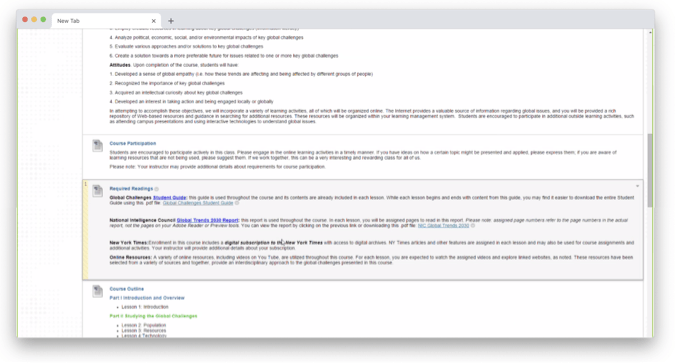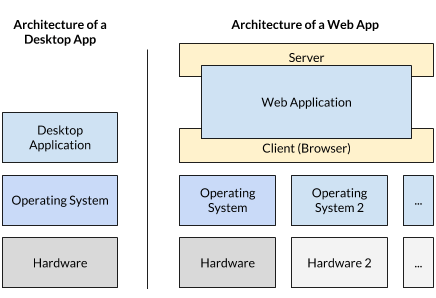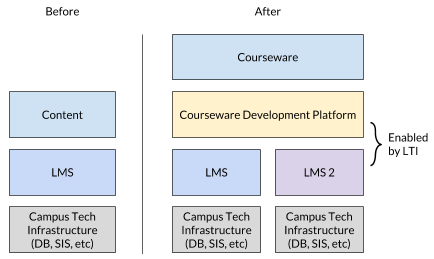To realize the true potential of digital learning, we must first change the software architecture at the heart of the education ecosystem.
In technology, the only thing constant is change.
While technology itself is changing rapidly — just consider the computing power of the average smartphone compared to a desktop 20 years ago — so, too, are user expectations.
But sometimes there’s a mismatch between what users expect and what they get. Worse, sometimes market conditions arise that prevent people from getting what they need, stifling innovation and progress.
At Smart Sparrow we know that all too well; most of our customers choose us because they’re unhappy with what they can (or, more often, what they can’t) do with their LMSs. Even though they all still need to make it work with their LMS.
What’s going on? Is it that LMSs don’t do what instructor and learners want? Actually, some people think they do exactly what instructors want, and that’s the problem. I tend to agree, but would add a slight qualification — I think LMSs do what most instructors wanted for 15–20 years, but there is now a shift in what instructors and learners expect.
That’s why we’ve created a new platform — aero — to fix what we think is dramatically broken in the digital learning ecosystem, and to forge the path toward a future we believe is worth pursuing.
We describe aero as a Courseware Design and Development Platform, which makes it a new product category. But we also made sure it works with any LMS, and in doing so we set out to change the software architecture at the heart of the digital learning ecosystem by separating the management of learning from the design of learning experiences.
In this post, I will introduce aero and explain how we see the market evolving and why we think we should re-architect the digital learning ecosystem.
But doing so will require us to cover a bit of ground. We need to talk about what LMSs, technically speaking, are, what type of software architecture they support, and why they fail to deliver on expectations and market needs. Last, I will describe how a new architecture can fix it, borrowing a lesson or two from the history of software platforms.
The LMS as an operating system [for learning]
When they were first introduced, learning management systems provided an easy way for higher education institutions to move their courses — or components of their courses — onto the web.
The problem LMSs were trying to solve was: “How can a university let each faculty member create a webpage for their course?”
It’s easy to tease out the two fundamental assumptions here:
- That creating a “course page” is what people who want to teach online should do, and
- Doing so is the instructor’s (AKA “Faculty Member” or “Academic”) responsibility.
We can argue whether these assumptions held true then, or hold true now, but nonetheless for a long time the LMS was the only game in town and a few companies solidified their dominant position in the market: first it was Blackboard, nowadays Canvas is taking the lead.
Because the LMS became a ubiquitous software platform used by virtually every school, it’s easy to find comparisons between LMSs and Operating Systems.
But before that we need to also establish that the courseware is essentially software.
Courseware is software
I don’t think a lot of people think of courseware as software. I do.
For a long time there was no single word to describe “the stuff that you put online in order to teach, and from which learners learn”.
The common phrases in the early 2000s were “learning objects” or “eLearning” or “online learning” but mainly it was just “content”. The problem with “content” is that it can be anything; a book is content, a lecture is content, and so is a TV show, a movie, an eBook, and a digital lecture. Thinking about “content” makes you say silly things like, “I already have the content (in my slides and lectures notes or my textbook), so I just need to put it online and then people will learn!” I wish it was so simple; if getting access to content was the problem, libraries would be the solution.
The MIT OpenCourseWare initiative, which began back in 2001, helped popularize the phrase “courseware”. It has steadily grown in popularity over the last few years, culminating when the Bill and Melinda Gates Foundation invested in the 2015 Next-Generation Courseware Challenge.
Distinguishing content for learning online as “courseware” helps drive home the message that these things are essentially learning experiences that are mediated through software. And this is important because there is now consensus that when we design software we need to worry about user experience first. Apple taught us the power of well-designed software-based experiences. Remember your Windows 95 programs? Now look at any iPad app.
So if we can agree that courseware is software used for learning, it’s easy to ask, “Ok, so what are these pieces of software built on?” Most of them today are built on LMSs.
My argument is that LMSs and OSs are both “underlying software platforms” that foster an ecosystem of developers and designers who create software-based experiences specifically for those platforms. In the desktop world you’ve got macOS or Windows — and a myriad of software developers and designers creating apps that run on them. In the digital learning context you’ve got Canvas, Moodle, Blackboard (or you name it) on top of which a host of software-based learning experiences run.
And — for what it’s worth — trainingindustry.com, a site dedicated to, as the name suggests, the training industry, also defines the LMS as “…a computer-based operating system used by training organizations to register, track, and monitor activity in the training function.”
LMSs aren’t delivering anymore
That the LMS delivered unsatisfied instructors and learners is easy to establish but harder to prove. Anecdotally, I can share that during my career I have met hundreds of educators who felt constrained by the limitations of the LMS. And I also know it first hand — I once felt this myself.
It all started when I was a teaching assistant in a physics lab. I built a type of an adaptive virtual lab to help our students get a better grip on what they were doing before they even set foot in the lab. It was Flash (remember Flash?) at the front-end and at the back-end, well, I had to implement my own little adaptive engine. The point though is that this work was not, and could not have been, built on the LMS then (2004, WebCT) or now (2018, Canvas). Later, that project became the basis of my research in Intelligent Tutoring Systems, which grew into the UNSW Adaptive eLearning Research Group, which ultimately spun out to become Smart Sparrow.
These are perhaps personal anecdotes. So what about the opinions of trusted 3rd parties?
Reviewing the LMS market for close to 2 decades, Michael Feldstein concluded in a 2014 piece titled “Dammit LMS” that the reason the LMS is disappointing is exactly because faculty get what they want. He writes:
“Do you want to know why the LMS has barely evolved at all over the last twenty years and will probably barely evolve at all over the next twenty years? It’s not because the terrible, horrible, no-good LMS vendors are trying to suck the blood out of the poor universities. It’s not because the terrible, horrible, no-good university administrators are trying to build a panopticon in which they can oppress the faculty. The reason that we get more of the same year after year is that, year after year, when faculty are given an opportunity to ask for what they want, they ask for more of the same.”
That was 2014, and in 2016 his colleague Phil Hill predicted that “the LMS market glacier is melting.”
“Most schools are no longer looking for just one system to manage the virtual classroom. We are now seeing entire institutions, such as Southern New Hampshire University and University of Maryland University College, designing new architectures where the LMS is but one core component. This move is enabling broader adoption of pedagogical approaches, such as competency-based education and personalized learning.”
I tend to agree with both Michael — yes, the LMSs do suck — and Phil — there is hope in re-architecture. But my vantage point in the industry allowed me to notice that perhaps something slightly different is going on: LMSs were good for the first wave in digital learning, but there is a second wave coming.
The next wave in digital learning
Taking a step back, you notice the explosion in online learning over the last two decades happened in two distinct waves.
During the “first wave” the excitement was about the “anytime, anywhere” nature of the internet. The idea that you can listen to a lecture from the bathroom or participate in an online discussion on the bus was mesmerizing. But the model of “who does what” was the same as before, so the the solutions that emerged solved for finding ways to let instructors put their content online. That solution was LMSs, which allowed schools to mostly migrate their existing content onto static web-pages. The caveat: most content was digitization of analog content — posted lecture notes, videotaped lectures, and multiple choice quizzes. It worked for a while (arguably), but today it delivers low-fi, one-size-fits-all experiences that neither meet the expectations of a generation that grew up with smartphones nor really deliver learner success.
I think we’re in the early phases of the “second wave” (think of it as similar to “web 2.0” of the early 2000s). While the first wave was about “anytime, anywhere”, the second wave is about “personalization and engagement”. Folks are much more excited today about the idea of making the learning experience uniquely personalized to individual learners as well as profoundly richer, more engaging and motivating.
What drives the second wave are two fundamental shifts in the market. First: consumers expect more. Does it make sense to charge students thousands of dollars for what is essentially an HTML page with links to reading materials and a discussion board? Maybe, but I’m aware of a growing number of students who have gotten used to the super rich and personal experiences that Playstation, Netflix, and Facebook provide and may not think so anymore.

If all you have is a hammer, everything looks like a nail. If all you have is a LMS, everything looks like a LMS course. The “state of the art” in digital learning 2018 is a page with links to reading material. We can do better.
The second shift in the market is more profound: according to Eduventures, 95% of universities plan to launch online degree programs by 2020 — which will compete nationally, if not globally.
What exactly will they compete on? Price? That will simply lead to a-race-to-the-bottom price war. They must compete on something else: the quality and value of their programs. And as more education providers realize that the digital medium is simply a new teaching environment, they realize that, just like they invest in great lecture halls and fancy campus facilities in order to attract students, they must also invest in great digital learning environments and experiences that are richer, smarter, prettier, you name it.
But creating such courseware requires not only better tools, it also requires designing purposefully to the medium. It’s no longer enough to ask an instructor to “post their content” onto an LMS. To meet the affordances of the digital medium we need a different approach altogether — it requires new tools, new production process, mostly though, it takes a team.
That’s what they mean when they say that teaching isn’t a solo sport anymore. To create great digital learning experiences, you need more than subject matter expertise; you also need people who know how to teach digitally: learning designers (AKA instructional designers) and folks that dig software, like user experience designers, graphic designers, and even developers. Schools that get it have already hired such production teams; schools that are behind still battle with their instructors to post their content on the LMS.
Taking stock
So let’s summarize for a second what’s going on. The “first wave” in digital learning was all about instructors posting their content online. LMSs establish themselves as the “operating system” layer in what evolved to become a digital learning software ecosystem. We’re now in the beginning of the second wave, as evolving consumer expectations and heated competition among providers lead to a surge in demand for better quality programs — which means richer, more engaging, and more personalized digital learning experiences (i.e. courseware) — which are simply impossible to create with LMSs.
We have a situation where the “operating system” prevents innovation.
Weird, that feels familiar.
A silver lining?
Can we solve it? Are we there yet? The answer is yes, we can (!) but in order to understand how, we need to venture into a bit of a technical discussion and speak some “softwarese”. The solution is curiously geeky, in that it’s about a new software architecture that’s enabling, for the first time, a change in the “locus of control” in the digital learning ecosystem.
And it has been done before, in a different time, in a different place, though not in a galaxy far, far away. It was done in the battle between operating systems (OS) and browsers, a saga known as “The Browsers Wars”, which tells an amazing story about the power of software re-architecture.
The Browser Wars: a brief history
Think 20 years back to the late 1990s. The Y2K bug is selling headlines. The internet is finally getting popular — though most people are using 56KB modems (oh that sweet, awesome sound of the good-old 56K6 dial-up modem!). The “dot.com bubble” keeps inflating. One new startup, Google, recently launched yet another search engine and no one seems quite sure if they’ll ever find a business model. Apple is largely a failing manufacturer of pricy personal computers with somewhat awkward interfaces, a painful lack of useful applications, and a market cap of around $7BN. Forrest Gump taught us that life is like a box of chocolates.
And then there is Microsoft. In fact, in the world of personal computers, there is mostly Microsoft. The tech universe in the ‘90s is pretty much a unipolar world with one gigantic Microsoft enjoying a market cap of around $600BN (and that’s in 1999, so over $900BN adjusted for inflation today). Microsoft is so big and influential, they are considered the largest monopoly in living memory.
Their Windows operating system runs more than 93% of PCs and their Office product suite is de facto the only productivity suite in town. In fact, Windows is so ubiquitous that if you’re in the computing business, be it hardware or software, and if you dream that your product will run on personal computers, you must first and foremost ensure it runs on Windows.
It’s not hard to see why Windows took off — the operating system solved two big problems. First, it dramatically decreased friction in the software marketplace by allowing developers to “write once, run anywhere” — where “anywhere” meant on any PC that runs Windows. This solved an immediate problem for other software developers: instead of coding to many different hardware configurations, they could code their app (such as a spreadsheet or game) for that single, ultra-popular OS, and the OS handles the complexity of working with whatever hardware it is installed on. At the same time, Windows (starting with Windows 95) offered a user interface that accessible and easy-to-use for individuals without formal training — an important attribute, given the rapid rise of PCs. In 1993, only 23% of households had a PC. By 1998 that number had almost doubled to 42%.
While the OS started as an “invisible layer” that connects all of the applications on a device, over time it evolved into a virtual desktop suite — and as Microsoft began bundling more and more pre-installed applications with their OS, they both wiped out vendors with competing applications and increased their own power.
The PC-based OS was the only game in town — until it wasn’t.
The emergence of the internet threatened Microsoft’s dominance. Using the internet, it’s now possible to store files on remote hard drives and invoke commands that run on remote devices. And the crucial piece is that these remote computers can run whatever operating system they feel like, i.e. not Microsoft Windows.
As a result, the internet allowed a new generation of applications to be developed in a way that changes the locus of control away from the desktop operating system.
These newly termed “web applications” manifest a crucial change to the desktop software architecture ecosystem — instead of monolithic applications that rely solely on the local OS, they split computing between a remote Server and a local Client hosted within a new piece of software called an Internet Browser.[1] Browsers effectively act as an intermediate layer between the server-based applications and the local operating system, enabling a new type of “write once, run anywhere”, where “anywhere” is now any browser. Freedom!!

Re-architecting the software ecosystem:
from desktop apps to web apps
Microsoft is rightly concerned by the freedom that the internet and browsers have unleashed. As they should be — it threatens their entire OS-based ecosystem. Their response is to attempt to maintain control over all pieces of their software platform by owning the browsers as well. They release Internet Explorer (IE) and ship it for free with Windows, claiming — somewhat not illogically — that such capability should be inherent to any OS. And, despite being famously late to the game, Microsoft overpowers the popular browser of the time, Netscape, and in less than 5 years claims 99% market share. By bundling a browser into the OS for free, why would anyone buy Netscape?
Developers are not happy. If Microsoft controls the access point to the web, they can make sure it’s not as sleek and seamless as their desktop-based platform, because it’s in their best interests to keep most users (and developers) on their platform instead of the web.
Two things happen next. First, Netscape — the IPO of which is famously attributed to igniting the late ‘90s dot.com bubble — goes bankrupt, open sources their browser, and establishes Mozilla Foundation, a nonprofit that eventually launches the Firefox open source browser with a mission to liberate the web. In parallel, the U.S. Department of Justice sues Microsoft, claiming it abused its monopoly power in an anti-competitive way.
The rest, as they say, is history. The inevitable advent of the internet and the successful proliferation of browsers led to the emergence of an alternative software architecture, powering a new breed of web-enabled, browser-accessed applications which unlocked creativity and innovation for thousands of companies. Over time, more and more companies created software applications accessible first and foremost through a browser. Microsoft began losing its footing.
Google, Facebook, and Amazon… none would exist if it wasn’t for browsers, and the new architecture, that later came to be known as the Web Platform. These three all ballooned into tech giants, unleashing unprecedented waves of innovation and progress — all because the world was unshackled from the OS.
Eventually, Google went after Microsoft’s last stronghold, the MS Office application suite, with Google Apps. In 2010, TechCrunch wrote:
“There’s no question that Google is setting its sights on taking some of Microsoft’s marketshare in the productivity suite space. […] Google Apps has steadily been growing; already 25 million people are using the Apps product. And that also includes over 2 million businesses ranging from startups, to small businesses, to Fortune 500 companies. And Google is developing a compelling ecosystem around Google Apps, recently launching the Google Apps Marketplace, which is an an app store for enterprise apps in the cloud.”
Today we can call an end to Microsoft’s monopoly over the computer industry. They’re still hugely profitable, massive, and in control of a huge share of the operating system market, but they aren’t the tech universe’s sole superpower anymore. There is room for more players in the ecosystem.
This is what happens when new platforms change the software architecture at the heart of an ecosystem.
Back to the future: re-architecting the digital learning ecosystem
Consider this: the web platform, embodying a split software architecture (server – browser), was the thing that ultimately set the desktop software ecosystem free from the grip of the OS vendors (chiefly Microsoft) of the ‘90s, ushering creativity, progress, and innovation.
Is there a similar split that can happen in the digital learning ecosystem?
What if we can introduce a new intermediate layer between courseware and LMS? We will keep LMSs for the tasks they were originally invented for — management of the learning process (enrollment, administrations, access control etc) — but dedicate the new layer to the tasks of designing the experiences themselves.
Such split architecture will enable another type of “write once run anywhere”: you can create your courseware once, and run it on any LMS. We call this layer the a Courseware Design and Development Platform.
The goal of such intermediate layer, dedicated to the design and development of courseware, should be to make it easier for teams (because if we’re looking into the future, we’re not talking about individual instructors anymore) to focus on designing great digital learning experiences, regardless of the constraints of any specific LMS.
Using client-server architecture shifted computing away from the constraints of the desktop operating system to remote servers that could run whatever system developers wanted, allowing them to invent whatever they felt like, at the speed they needed to.
Similarly, introducing a new layer on top of the LMS can allow courseware developers to move faster (faster for example than, say, Blackboard’s release cycle), and do what they need.
Here are some examples: how about making a course look like anything other than the standard weekly-based list of links; or creating an adaptive course, unit, or lesson; what about adding just-in-time recommendations to your courseware that will direct learners to resources they may find useful as they work through a lesson; what about getting learner data into your analytics engine to do whatever analysis you feel like doing with it; or creating location-aware lessons; or tracking what learners do inside a rich interactive sim and using that to dictate what lessons to show a few weeks down the track; you can connect to whatever badging system you feel like; incorporate VR or AR or virtual field trips… you get the point. If you only have a LMS to build on, good luck — you’re stuck with that particular LMS’s toolset and their release cycle, just like developers in the ‘90s were stuck with the desktop OSs.
Re-architecting the software architecture at the heart of the digital learning ecosystem will set you free.

Re-architecting digital learning: adding a dedicated courseware design and development platform between the LMS and learning experiences will free developers from the constraints of the LMS’ limited toolsets.
We designed aero as a Courseware Design and Development Platform. Its mission is to liberate educators and learning designers in the same way that browsers liberated developers. We made it work with any LMS, and in doing so we set out to change the software architecture at the heart of the digital learning ecosystem.
If we get this right, we believe we’ll hit the accelerator on quality digital learning.
Students should get what they expect and what they need — intelligently personalized and fantastically engaging experiences — while education providers should be able to design quality experiences that make them shine in a unique, differentiated way at a price they can afford. And the focus should be on quality.
What’s the alternative?
Let’s wrap it up
Technology changes, and so do consumer expectations. In the digital learning and teaching universe, we see a tectonic shift that is fueled by evolved consumer expectations, coupled with growing competitive pressure, leading to a new wave of richer, smarter, personalized learning. But it won’t happen unless we unshackle from the constraints of LMSs. This is doable if you re-architect the software platform at the heart of the ecosystem by separating design from management.
Which is what aero does.
And it’s a big deal.
Dror Ben-Naim
P.S. Shorter summary still:
- Past: instructors posting content to LMSs.
- Future: teams creating engaging and personalized courseware using dedicated tools.
Footnotes:
- Client-server architecture was not, in and of itself, particularly new. Early mainframe systems implemented it back in the ’70s. What was new was applying it in the realm of internet-connected applications running on PCs; what was new was that it was revived in an attempt to liberate developers world-wide.



